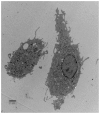The Diverse Roles of Microglia in the Neurodegenerative Aspects of Central Nervous System (CNS) Autoimmunity
- PMID: 28245617
- PMCID: PMC5372520
- DOI: 10.3390/ijms18030504
The Diverse Roles of Microglia in the Neurodegenerative Aspects of Central Nervous System (CNS) Autoimmunity
Abstract
Autoimmune diseases of the central nervous system (CNS) involve inflammatory components and result in neurodegenerative processes. Microglia, the resident macrophages of the CNS, are the first responders after insults to the CNS and comprise a major link between the inflammation and neurodegeneration. Here, we will focus on the roles of microglia in two autoimmune diseases: the prevalent condition of multiple sclerosis (MS) and the much rarer Rasmussen's encephalitis (RE). Although there is an abundance of evidence that microglia actively contribute to neuronal damage in pathological states such as MS and RE, there is also evidence of important reparative functions. As current research supports a more complex and diverse array of functions and phenotypes that microglia can assume, it is an especially interesting time to examine what is known about both the damaging and restorative roles that microglia can play in the inflammatory CNS setting. We will also discuss the pharmacological approaches to modulating microglia towards a more neuroprotective state.
Keywords: Rasmussen’s encephalitis; autoimmunity; microglia; multiple sclerosis.
Conflict of interest statement
The authors declare no conflict of interest.
Figures


References
Publication types
MeSH terms
Substances
Grants and funding
LinkOut - more resources
Full Text Sources
Other Literature Sources
Medical
Research Materials

